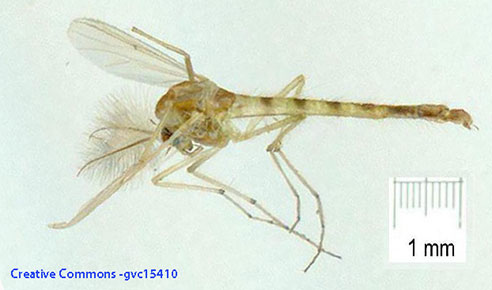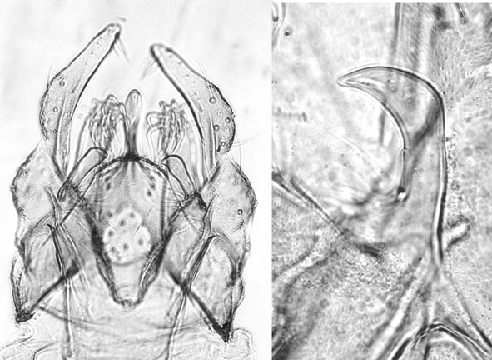Chironomus "orientalis"This species is related to C. flaviplumus in Japan, but requires a new name (Martin 2011b), so C. orientalis is suggested, as the species is widespread in Asia. Adults:  Adult from Queensland (photo by Graeme V. Cocks) See here for proposed Holotype male.  Wing length: 2.85 - 3.15 mm; wing width 0.30 - 0.67 mm. VR about 1.02-1.07; abt 2-4 SCf on brachiolum; 9-14 setae in squamal fringe. Generally greenish, with light brown thoracic vittae and postnotum, legs unmarked, abdomen with brown saddle spots on segments II-V, then mostly brown. Legs pale. Frontal tubercles about 33-39 µm, and about 13 µm wide. About 11-22 clypeal setae. Palp proportions (micron): 44 : 53 : 189 : 222 : 315 Thoracic setae - achrostichal about 12-18; dorsocentral about 12-18; prealar about 4-6; supra alar 1; scutellar in 2 approximate rows, 6-7 in anterior row, 11-17 in posterior row. Leg lengths (micron) and proportions as follows:
Setae on 9th tergite: 9-12; some setae on inferior volsellae with a simple or trifid fork; gonostylus reduces gently or sharply from about the midpoint. Female: Leg proportions (micron)
Fore Ta4 about same length as Ta3. About 91-96 Sensilla chaetica on hind tibia. Differences from other members of the C. samoensis/flaviplumus group: Molecular Sequence: Proposed type series: Holotype male: Radon Creek, Kakadu National Park ANT.15.3 Egg mass #3, reared male 3. Allotype female: details as holotype, female 1. Found: Northern Territory - Radon Creek, Kakadu National Park; (12.75°S, 132.93°E); Twin Falls, off Jim Jim Road, Kakadu area Indian specimens described by Chattopadhyuy et al. (1991), are not the same species and one has been renamed C. indiaensis (Martin 2011b), while others are the widespread species PK2. Australian adults of this species can be bred in the laboratory, as fertile egg masses were obtained from adults reared from wild collected larvae. The related Japanese species has also been maintained in a laboratory culture (Elbetieha & Kalthoff 1988). |
Modified: 21 June 2020
Access: Unrestricted
Copyright © 2005-2020, Jon Martin.